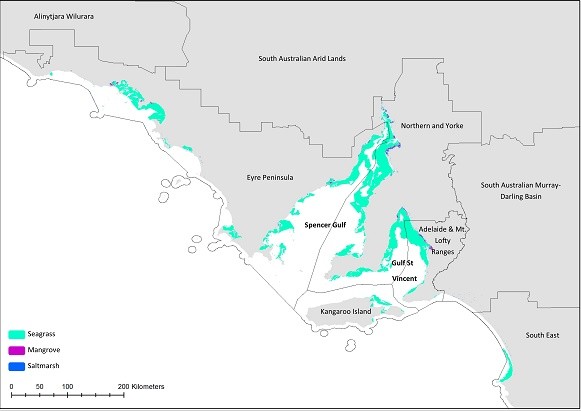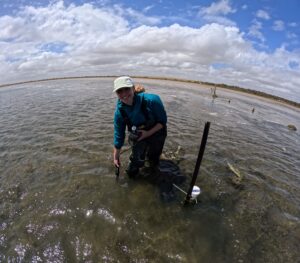A report released this month by the Goyder Institute for Water Research summarises the most comprehensive data available for blue carbon in South Australia, outlining the blue carbon ecosystems within the state and their estimated blue carbon stocks and sequestration rates. Blue carbon refers to carbon that is captured and stored in coastal vegetated ecosystems.
The Goyder Institute blue carbon research projects: synthesis report draws on two years of intensive research into SA’s blue carbon ecosystems and their potential to mitigate the effects of climate change through the Institute’s Coastal Carbon Opportunities and Salt to C collaborative projects. The Coastal Carbon Opportunities project was led by Professor Bronwyn Gillanders, University of Adelaide, with colleagues from Edith Cowan University, SA Water, SA EPA, CSIRO, and the University of Adelaide. The Salt to C project on a tidal re-connection trial was led by Professor Sabine Dittmann, Flinders University, with colleagues from University of Adelaide, Flinders University, UniSA, Department for Environment and Water (DEW) and the Australian National University.
It is estimated that South Australia holds around 1.12 million hectares of blue carbon ecosystems, which is over 7% of the blue carbon habitat of all of Australia. Within South Australia, seagrass beds account for 96% of blue carbon ecosystems, followed by tidal saltmarsh and mangrove with nearly 2% each. These ecosystems are very effective carbon stores because they continually sequester carbon from the environment, often sequestering much greater amounts of carbon, and storing it for longer periods, than many terrestrial ecosystems.

“Drawing on data from both projects, we found that mangroves and salt marsh habitats tend to have more carbon stored per hectare but because seagrass occupies a much larger area of water than those other habitats, there’s more carbon stocks within the seagrass habitats,” said Prof Bronwyn Gillanders.
The synthesis further revealed similar trends with carbon sequestration (i.e. the amount of carbon that is taken from the atmosphere and stored in the ecosystems). Although mangroves had the highest sequestration rate (median 1.79 tCO2e/ha/year), seagrass had the greatest total amount of carbon sequestration at the state level because it covers a larger area. The total accumulation rate for all of SA’s blue carbon ecosystems was estimated to be between 0.36 and 0.83 MT CO2e per year, or around 1.8–3.6% of the state’s annual greenhouse gas emissions.
The synthesis also exposed knowledge gaps and compiled a Research agenda for blue carbon in South Australia.
“The research agenda lays out the way forward to build up the database on blue carbon, inform national greenhouse gas inventory reporting, and support emerging blue carbon activities in South Australia” said Prof Sabine Dittmann, adding: “Building on the Goyder projects, further research on blue carbon can make South Australia a leader in integrating coastal management and climate change mitigation.”
Coastal ecosystems are of significant interest for national and regional climate change mitigation strategies – their conservation, restoration and creation have the potential to increase carbon capture and storage, mitigate climate change and support carbon offset opportunities. They also provide many other important ecosystem services, like improved water quality, tourism, fisheries and shoreline protection.
The Institute’s research is already having an impact, feeding into a blue carbon strategy for South Australia that is being developed by DEW and the Premier’s Climate Change Council.
“These Goyder projects are a good example of applied research informing policy development,” said Dr Neil McFarlane, Director, Climate Change, Coast and Marine, Department for Environment and Water.
“The research has contributed substantially to understanding the blue carbon potential in South Australia. In particular, our understanding of carbon stocks and sequestration rates in South Australia’s coastal ecosystems and the opportunities for blue carbon projects across the State,” said Neil, “and the team have also provided further recommendations to identify knowledge gaps and propose further research.”
For more information, download the Goyder blue carbon research projects: synthesis report to read the critical summary of the Institute’s blue carbon research projects, or the Research agenda for blue carbon for South Australia, which outlines recommended research directions.


